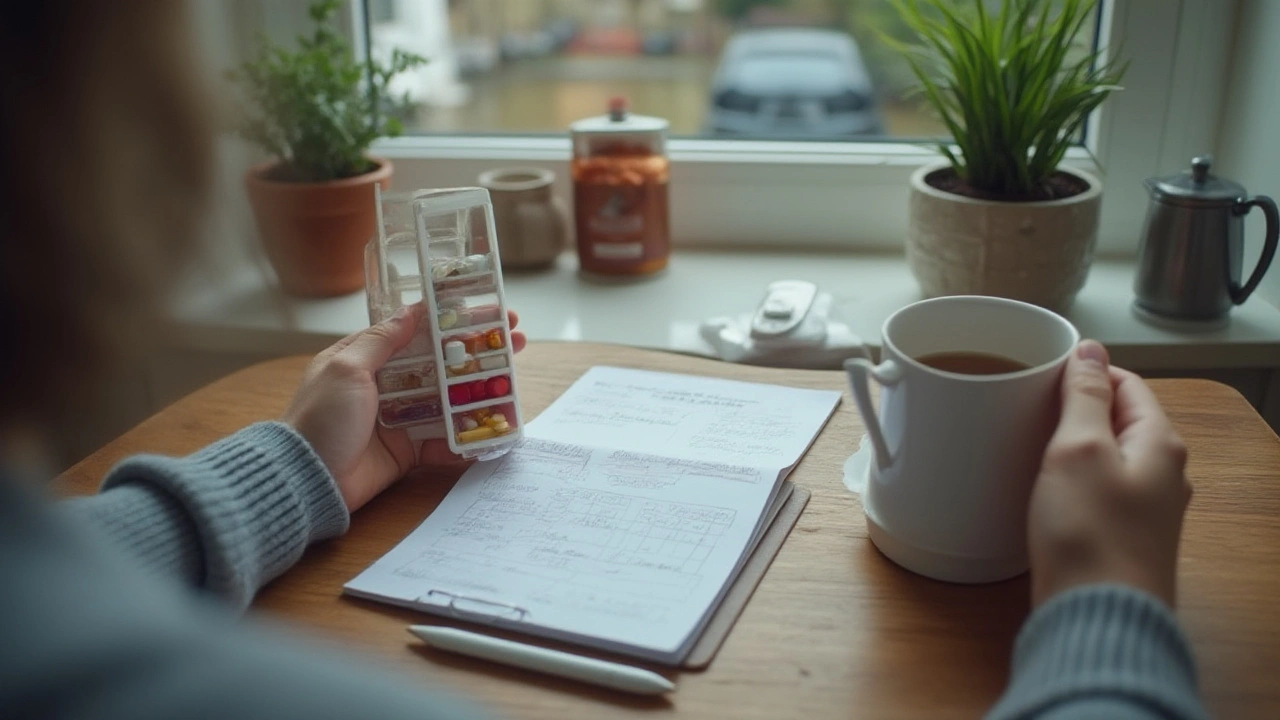Trandate might sound like the trendy name of an app, but millions of people know it as something way more important—a lifesaving medication for blood pressure. Ever noticed how sneaky high blood pressure can be? You could feel normal, but your arteries are taking a beating. Trandate, or labetalol if you want to get technical, steps up to handle those hidden risks. But what’s really going on in your body when you take it? Let’s open the bottle and see what’s inside.
What Is Trandate and How Does It Work?
First up, Trandate isn’t some weird new experiment. Doctors have trusted it for decades, ever since it hit the U.S. market in the 1980s. The generic name—labetalol—pops up in tons of textbooks and medical charts. It’s a prescription-only medicine, so you won’t find it next to the Tylenol at the gas station. Trandate tackles high blood pressure (the fancy word: hypertension), but it’s not just a one-trick pony. Doctors use it for sudden spikes in blood pressure, especially during pregnancy where other drugs can be risky. Cool, right?
So, what sets Trandate apart? Most blood pressure pills belong to one club, like beta blockers or alpha blockers. Labetalol actually joins both. It blocks “beta” receptors (which control your heart’s speed and strength) and “alpha” receptors (which affect how tight your blood vessels squeeze). Drop the squeeze, slow the heart, and you get lower blood pressure—simple as that. Here’s where things get interesting: because Trandate hits two targets, it can help in situations where other meds fizzle out. It’s a regular MVP in the emergency room for blood pressure emergencies.
Wondering how fast it works? When taken by mouth, it starts kicking in within 20 minutes to two hours. For emergencies, it can be injected directly and works even faster. Doctors adjust the dose based on your numbers and what your body needs—no cookie-cutter plan here. While most folks take it twice a day, some need three or four doses. It comes as tablets (100 to 300 mg), and there’s an injectable version for hospital use.
If you’re the technical type, here’s a snapshot of Trandate’s pharmacology:
| Feature | Details |
|---|---|
| Drug Class | Beta and Alpha-1 Adrenergic Blocker |
| Onset (oral) | 20 minutes to 2 hours |
| Duration (oral) | 8 to 12 hours |
| Metabolism | Liver |
| Pregnancy Use | Often preferred for preeclampsia |
| Available Forms | Tablets, Injection |
Trandate can lower blood pressure enough to make you feel dizzy at first—especially if you stand up too quickly. It’s simply your body adjusting, but it’s a classic quirk worth knowing. So, the next time you see "labetalol" on your prescription bottle, realize it’s more than a mouthful—it’s a carefully designed tool, not a blunt instrument.
What Conditions Does Trandate Treat?
It’s obvious now, but doctors don’t just hand out Trandate for every runny nose. Its superstar use is for high blood pressure. Tons of people—1 in 3 adults in the U.S.—walk around with hypertension. That’s a lot of stressed-out blood vessels. Here’s where Trandate takes center stage:
- Chronic Hypertension – this is your day-in, day-out high blood pressure. Preventing heart attacks, strokes, kidney problems? That’s the main game.
- Hypertensive Emergencies – think of blood pressure shooting through the roof, out of nowhere. Maybe from a crisis, surgery, or pregnancy issues like preeclampsia. In these moments, doctors turn to the injectable form to bring things under control—quick.
- Preeclampsia and Eclampsia – pregnancy can get complicated, and high blood pressure is a big risk for both mom and baby. Some older blood pressure drugs are a no-go for pregnancy, but Trandate actually has a good safety track record. It’s a favorite choice when fast action is needed.
- Heart Conditions – sometimes it’s not just about blood pressure. Trandate can help with certain types of heart rhythm problems (arrhythmias), though it’s not always the first choice.
People who don’t tolerate other beta blockers well—maybe due to asthma or diabetes—sometimes do better with Trandate since it works differently in the body. But it isn’t perfect for everyone. If you’re allergic to beta blockers, have heart block, or slow heart rate problems, Trandate can actually cause trouble. Always make sure your doctor knows your health history.
Ever wondered why your doc might switch you to Trandate from your usual medication? It often boils down to side effects, pregnancy needs, or the need for a rapid drop in blood pressure. Or maybe other meds simply didn’t do the trick. There’s no “one size fits all” in medicine—and that’s especially true here.
Here’s an interesting tidbit: In a large study published in 2023, people with tough-to-control blood pressure saw a bigger drop with labetalol than with some other common beta blockers, especially when it was combined with lifestyle changes.

Trandate Dosage, Tips, and What to Expect
If you’re picking up a prescription for Trandate, brace yourself for a little fine-tuning at first. Doses aren’t just set and forget. Most people start with a low dose—maybe 100 mg twice a day—and your doctor will bump it up slowly until you hit the sweet spot. Too low, and your numbers won’t budge. Too high, and you’re more likely to bump into side effects like lightheadedness or fatigue.
Consistency really matters with this med. Take it at the same time every day, like clockwork. It doesn’t matter much if you take it with food or without, but some people find it easier on the stomach during a meal. If you ever miss a dose, don’t double up. Just take the next one as usual. Mixing high-dose Trandate with alcohol? Bad mix. It can exaggerate the lowering of your blood pressure and leave you feeling woozy.
If your doctor tells you to stop Trandate, don’t just quit cold turkey. Suddenly dropping it can cause blood pressure to spike—a serious hazard, especially if you’ve been on it a while. Usually, it’s tapered down slowly for safety.
Kids and teens sometimes get prescribed Trandate, but the dosing is way more individualized since their bodies process meds differently. Always follow up closely if your child is on labetalol for any reason.
Ever had a stressful week and noticed your blood pressure readings swing like crazy? That’s totally normal. But don’t adjust doses on your own. Modern blood pressure monitors at home are super helpful—keep a log and show your doctor. That way, they can see the full picture and tweak your treatment if needed.
Quick tip: if you need surgery, tell your doctor you’re on Trandate. Some anesthetic drugs can interact or lower your pressure further, so it’s better to plan ahead.
Here’s a helpful checklist for Trandate users:
- Stick to your prescribed schedule.
- Keep a blood pressure diary.
- Watch for new symptoms and report them—a headache or heart racing could signal trouble.
- Don’t mix with alcohol or recreational drugs.
- Get up slowly if you feel dizzy or lightheaded.
- Tell all your doctors about every medication you take—not just Trandate.
Like any powerful medicine, Trandate works best when it’s teamed with healthy habits. People who cut back on salt, stay active, manage stress, and take their pills regularly usually see the best numbers. It’s the classic “pill plus lifestyle equals results” formula.
Possible Side Effects and Safety Facts About Trandate
Let’s be real—no medicine is perfect. Trandate has a reputation for being pretty well-tolerated, but sometimes your body will tell you it’s not a match. The good news? Most side effects are mild and settle down on their own after a week or two. Here’s what you might notice first:
- Dizziness, especially if you jump up too fast
- Tiredness or feeling rundown
- Nausea or upset stomach
- Headache
- Stuffed or runny nose (yep, seems random, but it happens!)
These are the usual suspects. Now, serious side effects are rare, but you shouldn’t ignore them. If you have chest pain, breathing trouble, a slow heartbeat, or swelling in your legs, get checked out—those symptoms need quick attention.
If you have asthma, Trandate can occasionally trigger breathing problems due to the way beta blockers work. Diabetics should also keep an eye on blood sugar, since Trandate can mask some warning signs of low blood sugar (like pounding heart).
Long-term studies actually offer some peace of mind; Trandate doesn’t seem to cause weight gain the way other beta blockers do, and it’s not known for messing much with cholesterol. For pregnant women, it’s a standout, especially for conditions like preeclampsia—much safer than a lot of older drugs out there.
If you ever wonder whether your symptoms are just part of "getting used to it" or something more, call your healthcare team. They really do want to hear from you before things escalate.
Here are some friendly reminders for long-term safety:
- Get your blood and liver function checked as recommended—it helps spot any silent issues.
- Don’t stop the medicine suddenly—always taper off under a doctor’s watch.
- Keep your medication away from pets and kids (it can be dangerous if ingested by accident).
- Store tablets at room temp, in a dry place—don’t keep them in the bathroom if you can help it.
If you’re one for details, here’s a quick look at side effect rates seen in clinical studies:
| Side Effect | Approximate Occurrence (%) |
|---|---|
| Dizziness | 13 |
| Fatigue | 12 |
| Nausea | 5 |
| Headache | 8 |
| Breathing difficulty (asthma) | Rare, <1 |
For most, Trandate is a steady friend. Knowing what to expect makes it less scary—and remembering why you’re taking this medicine helps you stick with it for the long haul.

The Bottom Line: Living Well With Trandate
Life with high blood pressure can feel exhausting—doctors, appointments, pills, home readings—it gets old, fast. But letting things slide just isn’t an option. Trandate gives many people an edge, especially those who haven’t found success with other medications or who need a safe, effective option during pregnancy. It’s not a “miracle cure” but more like a strong teammate working in the background.
Communicate openly with your care team. Ask questions until you understand. Tell them about every supplement, drug, or even special tea you drink—they all play a part. You don’t have to be a medical expert, but knowing the basics keeps you in control. So, if you or someone you care about is starting Trandate, breathe easy. It’s been used safely for decades, and each new study just adds to its reputation.
Remember to cheer yourself on—you’re not just taking a pill; you’re protecting your heart, brain, and kidneys for all those future adventures you want to have. And hey, that’s worth way more than any passing side effect. Got your questions ready for your next appointment? Bring them along. Your health story is yours to write, and Trandate might just be one of your best supporting characters.





Frank Pennetti
July 10, 2025 AT 01:23Alright, let's cut the fluff here. Trandate, aka labetalol, is a beta-blocker with alpha-blocking capabilities. That means it's doing dual inhibition on adrenergic receptors, which makes it quite potent hypotensively. But beware, this ain't some magic bullet.
Side effects? Expect the usual suspects—fatigue, dizziness, maybe some orthostatic hypotension if you're not careful. Not to mention it's contraindicated in asthma due to beta-2 blockade. They don't mention that enough.
From a pharmacological standpoint, labetalol's mixed receptor antagonism is a clever approach, but it demands rigorous patient selection and monitoring. If you misuse it or ignore contraindications, you’re courting disaster.
Honestly, if your doctor is sloppy with dosage adjustments, you could end up with exacerbated bradycardia or heart block. So get your labs, know your kinetics, and don't half-ass this therapy.
Anyone else find the common advisories on labetalol too sanitized? Where’s the real talk?
elvin casimir
July 10, 2025 AT 01:56Wow, I can't get over the countless grammar mistakes in these medical write-ups. Proper names like 'Trandate' should be capitalized constantly. The content might be good, but whoever wrote it has zero respect for English orthography.
Also, the phrase 'how it works' is overly simplistic for a medical article. Why not 'mechanism of action'? Precision is key.
Seriously, these sloppy errors distract from the valid content about labetalol's effects on alpha and beta receptors. Attention to detail should not be optional.
Anyway, beyond the editorial flaws, the drug is solid clinically but needs caution—especially since not everyone reacts the same.
Is it just me who believes medical info online must be held to higher linguistic standards? I'm triggered by this casual tone.
Steve Batancs
July 10, 2025 AT 02:30The post provides a decent overview, but I feel it lacks nuance in terms of contraindications. Labetalol is generally safe when prescribed appropriately, but the risk to patients with respiratory issues like asthma or COPD is non-negligible.
The mixed alpha- and beta-blockade indeed provides a robust control over hypertension but could complicate things in specific co-morbidities.
For those with cardiovascular concerns such as bradycardia or atrioventricular block, this medication must be prescribed with caution.
One addition I'd suggest is emphasizing the importance of patient education in adherence and understanding possible side effects.
Overall, it's a useful guide but could be enhanced by deeper clinical context for safety.
Ragha Vema
July 10, 2025 AT 03:03Guys, I've read too many horror stories about these big pharma concoctions. Labetalol? Seems too convenient that it magically controls your blood pressure while hiding a war chest of hidden dangers.
Have you looked into the long-term effects? There's barely any transparency on some of its more insidious side effects. Fatigue? Sure. But what about cognitive effects or risks of dependency on such medications?
Honestly, I wouldn't just trust the medical brochures. We've been sold a bill of goods repeatedly, and the truth is buried under jargon and euphemisms.
Does anyone else feel like the safety profile is hand-waved, ignoring the bigger picture of pharmaceutical interests profiting off of individuals' health?
Be vigilant, folks. Research thoroughly and never rely solely on official documentation.
Scott Mcquain
July 10, 2025 AT 03:36While I appreciate the intent behind this guide, I find it morally imperative to stress the risks related to improper use.
Too often, medications like labetalol are taken without due diligence, ignoring absolute and relative contraindications which might lead to dire consequences.
There's a responsibility on both prescriber and patient sides to uphold the highest standards when engaging with such treatments.
Moreover, the importance of ongoing monitoring and adherence to prescribed regimens cannot be overstated. Skipping doses or abrupt discontinuations can precipitate rebound hypertension or other serious events.
Your health is paramount; therefore, exercise caution and consult thoroughly before and during treatment.
Mariah Dietzler
July 10, 2025 AT 04:10Honestly, I think the guide is useful but kinda basic? Like it could have been better organized with bullet points or something.
The sections about side effects need more real-world examples to help people relate. For instance, how commonly do people feel dizzy or fatigued after starting labetalol?
Also, some notes on how to manage those side effects would be great too.
Maybe a short FAQ at the end would make it easier to understand without wading through dense paragraphs.
It’s not bad overall, just think a bit more effort in presentation would really help most readers.
Nicola Strand
July 10, 2025 AT 04:43As much as I appreciate a guide like this, I must oppose the idea that labetalol is entirely safe when used properly.
Every medication harbors risk, and a balanced perspective demands that side effects be given as much attention as benefits.
Furthermore, the 'tips for managing high blood pressure' feel generic and insufficiently tailored to individual contexts.
A better approach would include clear warnings about what signs necessitate immediate medical attention.
Otherwise, such guides risk encouraging self-medication or complacency.
Jackie Zheng
July 10, 2025 AT 05:16I appreciate the straightforward language here; it helps demystify a drug that sounds scary at first glance.
Labetalol is complex chemically, but the guide does a solid job breaking down its dual mechanism.
That said, I'm curious if anyone has experience balancing the fatigue side effect while keeping blood pressure in check? It can feel like walking a tightrope, right?
Also, the point about monitoring heart rate is crucial—many underestimate how this impacts overall wellbeing.
Thanks for opening up this space for discussion!
Hariom Godhani
July 10, 2025 AT 05:50Here is the deal, friends. Labetalol isn’t just a drug you gulp down and expect your blood pressure to dance to your command. What often escapes mention is the underlying physiological dance it forces inside your cardiovascular system.
Mistakes in its administration can trigger a cascade of adverse events that drag your health into chaos.
It's essential doctors carefully analyze each patient’s history — not the slapdash approach most seem to take.
I’ve witnessed firsthand the heartbreak from ignoring early symptoms that the drug triggers — it's devastating.
Yet, when used right, labetalol’s dual blockade is an impressive feat—though it demands respect and vigilance from all involved.
Jimmy the Exploder
July 10, 2025 AT 06:23This is yet another of those bland, overhyped posts that fail to dig into real-world dynamics.
Labetalol's so-called 'safety' is more questionable than they admit; people snicker about side effects but downplay them silently.
It’s telling how often fatigue or dizziness are just shrugged off — these impair quality of life massively.
Then there’s the dangerous mess of combining it with other meds that can amplify negative reactions. No warnings here? Please.
We need real transparency, not sugar-coated guides that act like these drugs are a cure-all.
Frank Pennetti
July 25, 2025 AT 02:13Expanding a bit, it’s essential to realize this isn’t your everyday beta-blocker. Labetalol’s alpha-blocking adds complexity—reducing peripheral resistance but also possibly causing reflex tachycardia early on.
Clinically, this can manifest variably depending on patient physiology and co-administered drugs.
I’ve seen too many lazy prescribers completely ignore titration protocols.
One size does not fit all; care plans must be crystal clear. Side effects like bronchoconstriction in asthmatics? A deadly oversight.
Peter out the dose slowly and monitor carefully. That’s where patient outcomes turn from avoidable disaster to effective control.
elvin casimir
July 27, 2025 AT 09:46About those titrations, the post should’ve properly emphasized that abrupt discontinuation can cause rebound hypertension.
It’s a common error, and despite the jargon feel, this is basic pharmacodynamics we all must respect.
Every credible medical source must double down on language precision and thorough instructions—especially about titration schedules and tapering.
Otherwise, errors shoot up, and patient safety tanks.
There’s no excuse for downplaying the severity of improper withdrawal from beta-blockers like labetalol.
Jackie Zheng
July 30, 2025 AT 21:06True, tapering off is crucial. From a patient perspective, sudden stopping can feel like being hit by a tidal wave of symptoms.
Glad you brought that up. It’s often overlooked in casual guides.
Maybe authors could include practical schedules or warning signs for patients to watch out for when discontinuing.
Knowing when to reach out to the doc could prevent hospital visits.
Clear, friendly guidance makes a world of difference.
Ragha Vema
August 3, 2025 AT 08:26Guys, I’m all here for safety tips, but let’s consider what really motivates these guidelines.
Pharma profits hinge on chronic usage, so the 'taper slowly' mantra might be as much about keeping sales steady as patient welfare.
Ever question why they never promote natural interventions the same?
It’s a cynical world out there, and meds like labetalol could be masking systemic issues rather than addressing root causes.
Just food for thought.
Hariom Godhani
August 7, 2025 AT 23:33While the conspiracy angle is tempting, we need to separate fact from fear.
Clinical evidence supports labetalol’s role when used with prudence.
However, I echo the need for patients to seek holistic health assessments, not just prescriptions.
Medicine is a tool, not a panacea.
The more informed we are, the better choices we make.